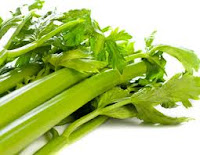The crunchy, nutty, celery we eat in salads, with a lovage-like flavour comes from the wild celery which still grows in the Mediterranean and parts of Asia . This is cultivated for its leaves and seeds (see celery seeds) and is not the firm textured stalk that we have in salads or use for dips. Celery was first used for its seeds and was used as medicine. It is called selino in Greek and its leaves were used like laurel leaves to crown athletes in the games that were held on mainland Greece Greece Rome
It was first recorded as being used for food in 1623, in France Europe . By which time the Italians had developed the one celery know today, more or less. It was the Italians who first cultivated celery seriously for food in the 17th century and they produced the kind with solid stems that we eat now; before the stalks were hollow. It was only introduced into the USA
 The origins of the word apium are obscure, but graveolans comes from the Latin, gravis meaning heavy (as in pregnant) or serious and olere to smell. It is a member of the Umbellifereae or Apiceae family of plants which includes parsley, carrots, fennel, and dill. The root of a variant of celery, Apium graveolans var. rapaceium is the root vegetable celeriac. The leafy variety that grows in the Mediterranean regions and is used to flavour soups and sauces is Apium graveolans var. secalinum. It also grows in
The origins of the word apium are obscure, but graveolans comes from the Latin, gravis meaning heavy (as in pregnant) or serious and olere to smell. It is a member of the Umbellifereae or Apiceae family of plants which includes parsley, carrots, fennel, and dill. The root of a variant of celery, Apium graveolans var. rapaceium is the root vegetable celeriac. The leafy variety that grows in the Mediterranean regions and is used to flavour soups and sauces is Apium graveolans var. secalinum. It also grows in  In
In There is some medical reason for this, as celery stalks are rich in the mineral potassium and contain phthalides, compounds which help relax muscles around arteries and allow the veins to dilate, so allowing blood to flow through them more easily. They also reduce stress hormones which can cause blood vessels to constrict.
Celery contains vitamins A and E which together help protect vision, particularly helping to protect night blindness and dimness of vision. It is also a rich source of vitamin K and vitamin C, and has many of the B-complex vitamins too. It also contains 17 amino acids, and the minerals calcium, iron, magnesium, manganese, molybdenum, phosphorous, selenium, sodium and zinc. So if you thought a stick of celery was only water, you should revise your opinion. Celery stalks also contain coumarins which help prevent the free radicals from damaging cells and causing cancer. These also enhance the white blood cells which help to defend our immune systems. They also contain acetylenics which have also shown activity which inhibits the growth of cancerous tumour cells. Eating celery can help to lower blood pressure, so helping to lower the risks of heart disease and strokes. The potassium and sodium combined help to regulate the body’s fluid balance, and so act as a diuretic, flushing out unnecessary fluids. Celery oil also has the effect of lowering cholesterol levels.
 It is thought that celery oil has anti-inflammatory properties, but more research is needed on humans before this can be proven.
It is thought that celery oil has anti-inflammatory properties, but more research is needed on humans before this can be proven. Celery makes a good healthy juice, especially when combined with parsley, which helps to prevent thrush or candida if you are susceptible to that infection, and it is tasty when combined with carrot juice. This can help calm frazzled nerves and can help the nervous system. If you drink half a pint of the carrot and celery juice daily it will help the nervous system.
The seeds are mainly used for medical reasons, but it is clear that adding celery to your diet can be beneficial to your health. It is best used raw to get its full benefits.
Ingredients
1 head of celery, sliced
1 bunch spring onions, chopped
30 gr walnuts, crushed
2 apples, cored and chopped
1 mango, peeled and roughly chopped
1 Kos lettuce, leaves left whole
white wine vinegar,
olive oil
parsley leaves, shredded
juice of 1 lemon
Method
Have a bowl of water near you into which you have squeezed the lemon juice. When you core and chop the apples, leave the chopped pieces in the water so that they don’t discolour for about 15 minutes, while you prepare the other ingredients.
Layer a salad bowl with the lettuce leaves, and put all the other ingredients into the bed of lettuce.
Make the vinaigrette with 2 parts olive oil to 1 part white wine vinegar.
Pour this onto the salad and serve, or serve separately.
This has Taste and is a Treat.




No comments:
Post a Comment